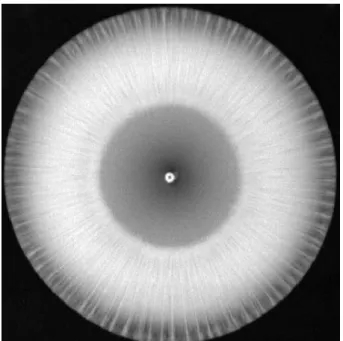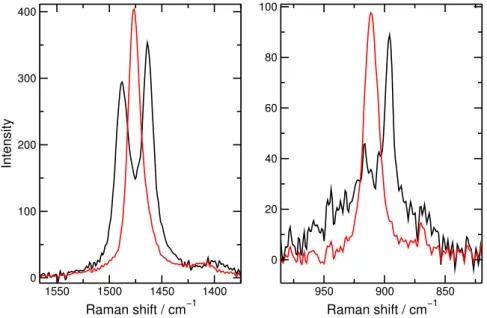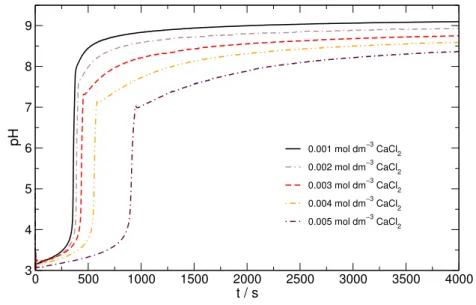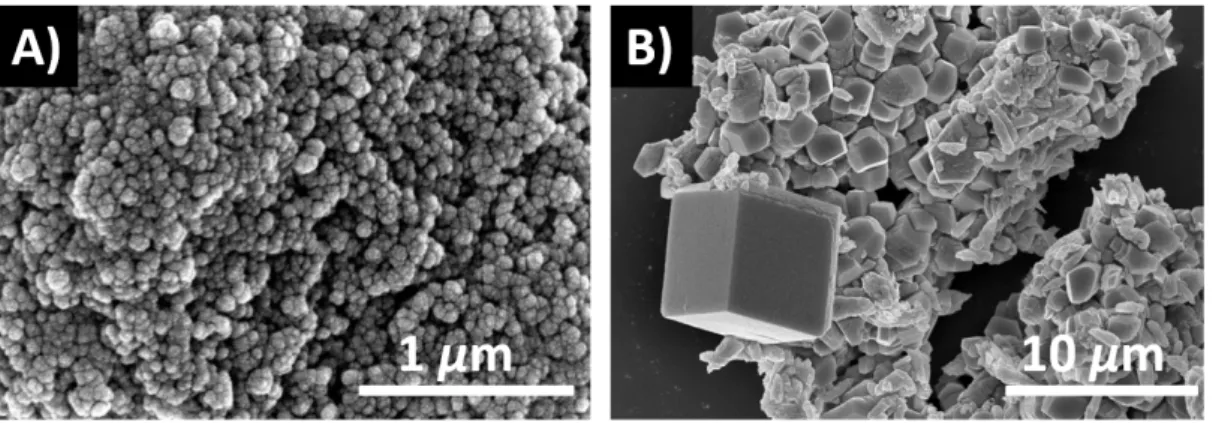Pattern Formation of Calcium Ion-Containing Precipitates
Theses of doctoral (PhD) dissertation
Bíborka Bohner
Supervisor: Dr. Dezs˝o Horváth, full professor
Doctoral School of Chemistry
University of Szeged, Department of Physical Chemistry and Materials Science
2017
1 Introduction and Aims
Periodicity is present in our days and determines our everyday life; for instance it includes sleep cycles, alternating seasons, or the sound, which is a periodic wave of pressure in the air. Further examples are the striped, dotted patterns on animals, or the colorful, eye-catching patterns on rocks. Interestingly, chemical systems are not different from these ones. The most important property of an oscillating chemical reaction is that the concentrations of the intermediates are changing periodically during the reaction. The conditions of this nonlinear behavior are: the reaction has to be far from the thermodynamic equilibrium, its mechanism has to include a positive feedback (autocatalytic or self-inhibiting step), and at least one negative feedback.
Some of the patterns that develop in chemical systems belong to periodic phenomena, as well.
The appearance of such patterns is ensured by the combined effects of reactions and transport processes. Transport processes occur when material, energy, impulse or charge moves. Particles can displace via three different ways: diffusion, convection or migration. In case of diffusion, a set of particles moves (diffuses) against concentration gradient. The displacement of charged particles triggered by electric potential difference is called migration, while the macroscopic fluid flow is the so-called convection.
Our research group examines the formation of filament-containing precipitate patterns, dur- ing which they demonstrated the role of fluid motion, which also influenced the microstructure of the precipitates. To clarify the causes of pattern formation, chemically different precipitates had to be investigated, therefore we have decided to work with calcium oxalate and calcium car- bonate. Unlike previous systems, these calcium ion-containing precipitates are involved in fast, instantaneous precipitation reactions. The aim of this study is to characterize the calcium ox- alate and calcium carbonate precipitate patterns, and to investigate which polymorph(s) is(are) evolving. In the literature, there are various methods for producing calcium carbonate. We tried one of them, in which an enzyme produces carbonate ion, the reactant of the precipitation reaction. We used the urea–urease reaction and completed with calcium chloride. Furthermore, we were interested in studying a nonlinear behavior, that is, a clock reaction when it produces a solid material, calcium carbonate precipitate.
2 Experimental Section
Experiments were carried out in a square-shaped glassware containing an aqueous solution of sodium oxalate or sodium carbonate. Using a peristaltic pump, calcium chloride solution was pumped into the glasssware, throughout an inlet at the bottom. This resulted in calcium oxalate or calcium carbonate precipitate pattern with radial symmetry. The developing pattern was recorded with a digital camera. Among experimental conditions, I changed the volume flow rate, concentrations, pH, the density difference between the reactant solutions, and the viscosity to determine the parameters responsible for pattern formation.
There is a significant pH change in the urea–urease–calcium ion reaction, which was de- tected by a pH meter, while a digital camera monitored the resulting precipitate. Continuous stirring was achieved by a magnetic stirrer and a stirrer bar in case of both the open and the sealed reactors. For evaluating data, I used homemade software that determine the geometrical parameters of the pattern (size of the circles, number of filaments, and the average height of gravity flow) and the relative amount of precipitate on the basis of grayscale intensity data.
The composition of calcium oxalate and calcium carbonate precipitates was determined by thermogravimetric, infrared spectroscopic, and Raman microscopic measurements. The mor- phology of the particles was investigated using both an optical and a scanning electron micro- scope.
Figure 1: Schematic illustration of the experimental setup, which is used in the flow-driven experiments.
3 New Scientific Results
I. At the bottom of the reaction vessel, the inflowing dense calcium ion-containing reactant – in case of appropriate concentrations and density differences – results in convection, which creates a regular, circularly symmetric precipitate pattern.
When concentrated and dense calcium chloride solution flows into dilute sodium oxalate solution, precipitate-rich parts form periodically around the inlet with circular symmetry (Figure 2). After further horizontal spreading, these parts lengthen, and filaments become visible. Additionally, there is precipitate among these radially growing filaments, but in significantly smaller quantities.
Figure 2: Calcium oxalate precipitate pattern formed under flow-driven condi- tions after 240 s. The bright parts of this photograph represent the precipitate pattern, while the black part indicates the background. Experimental conditions:
c(CaCl2) = 4.0 mol · dm−3, c(Na2C2O4) = 0.025 mol · dm−3, pH = 9.0, and qV= 20 cm3·h−1.
The role of density difference has been demonstrated with the dissolution of inert com- pounds (sodium chloride and glycerol) in the inflowing calcium chloride solution that does not take part in the precipitation reaction. Consequently, the added compound only increased the density difference between the reactants. The precipitation front follows the higher density reactant, which is flowing at the bottom of the fluid but also makes it spreading to a larger area.
II. Thermodynamically unstable calcium oxalate dihydrate crystals can be selectively pro- duced under flow-driven conditions using high excess calcium ions and high volume flow rates.
In the well-stirred system, calcium oxalate monohydrate precipitates. On the contrary, calcium oxalate dihydrate crystals form in the flow-driven system at 20 cm3·h−1volume flow rate (Figure 3). If the volume flow rate is further increased to 100 cm3 · h−1, the amount of calcium oxalate dihydrate crystals is continuously increasing in the sample, which were identified by Raman microscopy.
850 900
950
Raman shift / cm−1 0
20 40 60 80 100
1400 1450
1500 1550
Raman shift / cm−1 0
100 200 300 400
Intensity
Figure 3: Raman spectra of calcium oxalate particles formed under flow-driven condi- tions. The black curves belong to the calcium oxalate monohydrate (1463, 1490, and 896 cm−1), while the red ones represent the calcium oxalate dihydrate crystals (1477 and 911 cm−1).
III. Within the flow-driven calcium carbonate precipitate pattern, the morphology and size distribution of the crystals can be controlled with the volume flow rate.
In the well-stirred system, the mixture of calcite and vaterite crystals form. When calcium carbonate precipitate pattern is obtained at 20 cm3·h−1or greater volume flow rate, only the rhombohedral calcite form crystallize, which can be identified by Raman microscopy and scanning electron microscopy.
If volume flow rate is less than 20 cm3·h−1, the mixture of calcite and vaterite polymorphs precipitates. In increasing distance from the inlet, the size of both the vaterite spheres and the calcite rhombohedrals becomes larger. These experimental data is demonstrated by particle-size distribution diagrams.
IV. The urea–urease reaction is autocatalytic to hydroxide ions, and thus can show a clock reaction. By adding calcium ions to it, the induction period increases and the final pH decreases because of the precipitation reaction between the urease enzyme and calcium ions.
We have detected with Raman spectroscopic measurements that the enzyme precipitates with calcium ions under alkaline conditions in the clock reaction. During the control experiments carried out in pH = 9.18 buffer solution, calcium ions (without urea) also results in a precipitate having the same Raman spectrum.
Because the urease enzyme precipitates with calcium ions under alkaline conditions, the effect of less enzyme can be seen in the diagrams, that is, the induction period is lenght- ened, and the final pH is decreased (Figure 4). It means that the enzyme remaining active cannot produce sufficient base any more.
0 500 1000 1500 2000 2500 3000 3500 4000
t / s 3
4 5 6 7 8 9
pH 0.001 mol dm−3 CaCl2
0.002 mol dm−3 CaCl2 0.003 mol dm−3 CaCl2 0.004 mol dm−3 CaCl2 0.005 mol dm−3 CaCl2
Figure 4: Changing calcium chloride concentration in the urea–urease clock reac- tion. Composition: 0.08 mol · dm−3 urea, 20 u · cm−3 urease enzyme, 0.001–
0.005 mol·dm−3calcium chloride, and 3.0 mmol·dm−3hydrochloric acid solution.
V. The urea–urease–calcium ion reaction produces two types of solid phases under alkaline conditions: at low concentrations, the urease enzyme forms a precipitate with calcium ions; while using more concentrated solutions of the reactants, calcite develops as a con- sequence of the enzyme activity.
Using a scanning electron microscope we have detected an amorphous precipitate, which appears during the clock reaction. Using more concentrated solutions of the reactants, the enzyme reaction – besides osciallation – can produce rhombohedral particles, which resemble to calcite (Figure 5). By applying Raman spectroscopic measurements, calcite as well as the urease–calcium ion precipitate can be identified.
Figure 5: Scanning electron microscopic images of the amorphous urease enzyme–
calcium ion precipitate formed in the clock reaction (A), and the rhombohedral calcite crystals precipitated in the oscillating chemical reaction (B).
VI. There is transient pH oscillation and stepwise calcite production in the urea–urease–
calcium ion reaction.
I have detected the pH change with a pH meter, while the relative quantity of the precipitate has been determined from grayscale intensity data. It is seen in Figure 6 that the amplitude of the damped oscillation is∆pH = 0.3, and its period is approximately 500 s. In the urea–
urease clock reaction calcium ions remove carbon dioxide via the hydrogen carbonate ion–carbonate ion equilibrium in a form of calcium carbonate. This step results in the appearance of a solid phase and also reduces the final pH below 9.
0 1000 2000 3000 4000
t / s 0
25 50 75 100 125 150
I / a.u.
4 5 6 7 8 9 10
pH
Figure 6: pH oscillation and stepwise precipitation in the urea–urease reaction. Com- position: 1.0 mol · dm−3 urea, 20 u · cm−3 urease enzyme, 0.5 mmol · dm−3 hy- drochloric acid solution, and 0.25 mol·dm−3calcium chloride solution.
4 List of Scientific Publications
4.1 Scientific Publications Related to the Topic of the Dissertation
1. Flow-Driven Pattern Formation in the Calcium–Oxalate System Bíborka Bohner, Balázs Endr˝odi Dezs˝o Horváth, Ágota Tóth J. Chem. Phys.,144, 164504 (2016).
IF2015= 2.894
2. Morphology Control by Flow-Driven Self-Organizing Precipitation Bíborka Bohner, Gábor Schuszter, Dezs˝o Horváth, Ágota Tóth
Chem. Phys. Lett.,631–632, 114–117 (2015).
IF2015= 1.860
3. Self-Organization of Calcium Oxalate by Flow-Driven Precipitation Bíborka Bohner, Gábor Schuszter, Ottó Berkesi, Dezs˝o Horváth, Ágota Tóth Chem. Commun.,50, 4289–4291 (2014).
IF2014= 6.378
∑IF =11.132
4.2 Other Scientific Publications
1. Self-Assembly of Charged Nanoparticles by an Autocatalytic Reaction Front
Bíborka Bohner, Gábor Schuszter, Nakanish Hideyuki, Dániel Zámbó, András Deák , Dezs˝o Horváth, Ágota Tóth, István Lagzi
Langmuir,31 (44), 12019–12024 (2015).
IF2015= 3.993
2. On the Lack of Capillary Mössbauer Spectroscopic Effect for Sn(II)-containing Aque- ous Solutions Trapped in Corning Vycor ’Thirsty’ Glass
Éva Gabriella Bajnóczi,Bíborka Bohner, Eszter Czeglédi, Ern˝o Kuzmann, Zoltán Homon- nay, Attila Lengyel, István Pálinkó, Pál Sipos
J. Radioanal. Nucl. Chem., 302, 695–700 (2014).
IF2014= 1.415
∑IF =5.408
5 Lectures
5.1 Lectures Related to the Topic of the Dissertation
5.1.1 English Language Lectures at International Conferences
1. Japanese–Hungarian Workshop on Applied Mathematics and Complex Systems Bíborka Bohner, Gábor Schuszter, Dezs˝o Horváth, Ágota Tóth
Flow-Induced Precipitation in the Calcium–Carbonate System July 28, 2015; Budapest, Hungary
2. Complexity and Synergetics
Bíborka Bohner, Gábor Schuszter, Dezs˝o Horváth, Ágota Tóth
Flow-Induced Precipitation in Calcium–Oxalate and Calcium–Carbonate Systems July 8–11, 2015; Hannover, Germany
3. Seminar at the Department of Physical Chemistry, Université Libre De Bruxelles Bíborka Bohner, Gábor Schuszter, Dezs˝o Horváth, Ágota Tóth
Self-Organization of Calcium Oxalate and Carbonate by Flow-Driven Precipitation 2014, Brussels, Belgium
4. Gordon Research Seminar on Oscillations & Dynamic Instabilities in Chemical Sys- tems Conference
Gábor Schuszter,Bíborka Bohner, Ágota Tóth, Dezs˝o Horváth Self-Organization of Calcium Oxalate by Flow-Driven Precipitation July 20–25, 2014; Girona, Spain
5. Japanese–Hungarian Conference on Applied Mathematics and Nonlinear Dynamics Bíborka Bohner, Gábor Schuszter, Dezs˝o Horváth, Ágota Tóth
Self-Organization in the Calcium–Oxalate Flow-Driven System December 12, 2013; Budapest, Hungary
6. Debrecen Colloquium on Inorganic Reaction Mechanisms
Eszter Tóth-Szeles,Bíborka Bohner, Gábor Schuszter, Dezs˝o Horváth, Ágota Tóth Flow-Induced Precipitate Patterns in Metal–Oxalate Systems
June 11–15, 2013; Debrecen, Hungary 7. Chemical Gardens
Dezs˝o Horváth, Ágota Tóth, Eszter Tóth-Szeles,Bíborka Bohner Flow-Induced Precipitate Patterns in Metal–Oxalate Systems May 7–11, 2012; Leiden, Netherlands
8. International Workshop on Complex Systems in Chemistry, Physics, and Biology Dezs˝o Horváth, Tamás Bujdosó,Bíborka Bohner, Ágota Tóth
Flow-Induced Pattern Formation in the Calcium Oxalate Precipitation Reaction November 2–3, 2011; Budapest, Hungary
5.1.2 Hungarian Language Lectures at National Conferences
1. Reaction Kinetics and Photochemistry Working Group of the HAS, pre-defence Bíborka Bohner, Dezs˝o Horváth, Ágota Tóth
The Effect of Calcium Ion-Containing Precipitates on Pattern Formation May 29–30, 2017; Balatonalmádi, Hungary
2. Seminar at the Department of Physical Chemistry and Materials Science, University of Szeged, report of the work carried out during my PhD
Bíborka Bohner, Dezs˝o Horváth, Ágota Tóth
The Effect of Calcium Ion-Containing Precipitates on Pattern Formation May 11, 2017; Szeged, Hungary
3. Reaction Kinetics and Photochemistry Working Group of the HAS Bíborka Bohner, Gábor Schuszter, Dezs˝o Horváth, Ágota Tóth Calcium Carbonate Production in a Flow-Driven System March 26–27, 2015; Debrecen, Hungary
4. III. “Eötvözet” Conference
Bíborka Bohner, Gábor Schuszter, Dezs˝o Horváth, Ágota Tóth Flow-Driven Crystal Formation in the Calcium–Oxalate System May 9–10, 2014; Szeged, Hungary
5. XXXVI. National Student Chemistry Conference Bíborka Bohner, Dezs˝o Horváth, Ágota Tóth
Flow-Driven Pattern Formation in Calcium Ion-Containing Precipitates October 28–30, 2013; Szeged, Hungary
6. Reaction Kinetics and Photochemistry Working Group of the HAS Tamás Bujdosó,Bíborka Bohner, Ágota Tóth, Dezs˝o Horváth
Convection-Induced Pattern Formation in the Calcium–Oxalate Reaction October 27–28, 2011; Gyöngyöstarján, Hungary
5.2 Other Lectures
1. XXXIX. National Student Chemistry Conference
Bíborka Bohner, Tamás Pivarcsik, Dezs˝o Horváth, Ágota Tóth
Formation of Magnesium or Strontium Carbonate Precipitates in Flow-Driven Systems October 17–19, 2016; Szeged, Hungary
2. Autumn Radiochemistry Days
Attila Lengyel, Ern˝o Kuzmann, Éva G. Bajnóczi, Zoltán Homonnay, Bíborka Bohner, Eszter Czeglédi, István Pálinkó, Pál Sipos
Investigation of Tin(II) Solutions with Capillary Mössbauer Spectroscopy October 13–15, 2014; Balatonszárszó, Hungary
6 Posters
6.1 Poster Presentations Related to the Topic of the Dissertation
1. GRC Complex Active & Adaptive Material Systems
Bíborka Bohner, Evelin Rauscher, Eszter Tóth-Szeles, Dezs˝o Horváth, Ágota Tóth Flow-Driven Precipitation Systems
January 29–February 3, 2017; Ventura (California), United States of America 2. 251stAmerican Chemical Society National Meeting & Exposition
Bíborka Bohner, Tamás Pivarcsik, Dezs˝o Horváth, Ágota Tóth
Flow-Driven Precipitation in the Magnesium and Calcium Carbonate Systems March 13–17, 2017; San Francisco (California), United States of America 3. 250th American Chemical Society National Meeting & Exposition
Bíborka Bohner, Gábor Schuszter, Dezs˝o Horváth, Ágota Tóth
Pattern Formation Observed During the Flow-driven Precipitation of Calcium Oxalate and Calcium Carbonate
August 16–20, 2015; Boston (Massachusetts), United States of America 4. Symposium „Complexity and Synergetics”
Bíborka Bohner, Gábor Schuszter, Dezs˝o Horváth, Ágota Tóth
Flow-Induced Precipitation in Calcium Oxalate and Carbonate Systems July 8–11, 2015; Hannover, Germany
5. XXXIV Dynamics Days Europe
Bíborka Bohner, Gábor Schuszter, Dezs˝o Horváth, Ágota Tóth
Flow-Induced Precipitation in Calcium Oxalate and Carbonate Systems
6. Gordon Research Conference, Seminar on Oscillations & Dynamic Instabilities in Chemical Systems
Gábor Schuszter,Bíborka Bohner, Dezs˝o Horváth, Ágota Tóth Self-Organization of Calcium Oxalate by Flow-Driven Precipitation July 20–25, 2014; Girona, Spain
7. Emergence in Chemical Systems 3.0
Eszter Tóth-Szeles, Tamás Bujdosó,Bíborka Bohner, Gábor Schuszter, Dezs˝o Horváth Ágota Tóth
Horizontally Growing Precipitation Patterns in Flow-Driven Systems July 17–22, 2013; Anchorage, Alaska
8. Gordon Research Conference on Oscillations and Dynamic Instabilities in Chemical Systems
Eszter Tóth-Szeles, Tamás Bujdosó,Bíborka Bohner, Gábor Schuszter, Dezs˝o Horváth Ágota Tóth
Horizontally Growing Precipitation Patterns in Flow-Driven Systems July 15–20, 2012; Waterville (Alabama) United States of America 9. Chemical Gardens
Eszter Tóth-Szeles, Tamás Bujdosó,Bíborka Bohner, Gábor Schuszter, Dezs˝o Horváth Ágota Tóth
Horizontally Growing Precipitation Patterns in Flow-Driven Systems May 7–11, 2012; Leiden, Netherlands
6.2 Other Poster Presentations
1. 253rd American Chemical Society National Meeting & Exposition Bíborka Bohner, Ádám Balog, Dezs˝o Horváth, Ágota Tóth
Unusual Pattern Formation in the Cadmium–Hydroxide System
April 2–6, 2017; San Francisco (California), United States of America
MTMT identification number: 10043773




